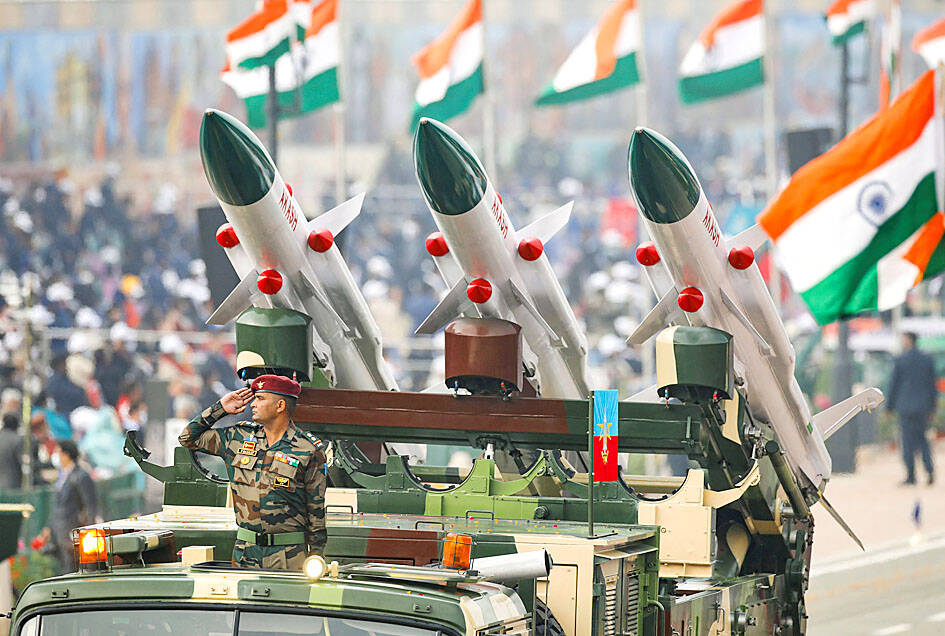New Delhi is to buy portable air-defense missiles to deploy along its border with China as militarization in the region gathers speed and hostilities between the two countries enter a third year.
The Defense Acquisition Council — headed by Indian Minister of Defense Rajnath Singh — cleared the purchase of the very short-range missiles that can be carried by troops, according to a statement issued late on Tuesday.
“In view of the recent developments along the northern borders, there is a need to focus on effective air defense weapon systems which are man portable and can be deployed quickly in rugged terrain,” the ministry said.

Photo: Reuters
Meant for neutralizing low-altitude aerial threats at close range, the missile is designed and developed by Indian research organization DRDO and is similar to US-made FIM-92 Stinger surface-to-air missiles.
Such defense missile systems have proved to be effective in recent conflicts and the Pentagon is providing at least 1,600 Stinger missile systems to Ukraine to fend off Russian air attacks.
Tensions along the Asian nations’ disputed border have simmered since a June 2020 clash — the worst in more than 40 years — left at least 20 Indian and at least four Chinese soldiers dead.
That fighting was centered around the Himalayan region of Ladakh, along their 3,488km border known as the Line of Actual Control.
Last month, troops clashed in the northeast Indian border state of Arunachal Pradesh.
Military commanders of the two nations have held 17 rounds of talks to attempt to defuse the border crisis, but progress has been glacial.
The ministry also cleared the purchase of locally made anti-tank missiles for helicopters and Brahmos anti-ship missiles for its warships.
The total cost of the military hardware would cost 42.76 billion rupees (US$523.7 million), but the ministry did not disclose the estimated price of each of the three items.

The US government has signed defense cooperation agreements with Japan and the Philippines to boost the deterrence capabilities of countries in the first island chain, a report by the National Security Bureau (NSB) showed. The main countries on the first island chain include the two nations and Taiwan. The bureau is to present the report at a meeting of the legislature’s Foreign Affairs and National Defense Committee tomorrow. The US military has deployed Typhon missile systems to Japan’s Yamaguchi Prefecture and Zambales province in the Philippines during their joint military exercises. It has also installed NMESIS anti-ship systems in Japan’s Okinawa

‘WIN-WIN’: The Philippines, and central and eastern European countries are important potential drone cooperation partners, Minister of Foreign Affairs Lin Chia-lung said Minister of Foreign Affairs Lin Chia-lung (林佳龍) in an interview published yesterday confirmed that there are joint ventures between Taiwan and Poland in the drone industry. Lin made the remark in an exclusive interview with the Chinese-language Liberty Times (the Taipei Times’ sister paper). The government-backed Taiwan Excellence Drone International Business Opportunities Alliance and the Polish Chamber of Unmanned Systems on Wednesday last week signed a memorandum of understanding in Poland to develop a “non-China” supply chain for drones and work together on key technologies. Asked if Taiwan prioritized Poland among central and eastern European countries in drone collaboration, Lin

NO CONFIDENCE MOTION? The premier said that being toppled by the legislature for defending the Constitution would be a democratic badge of honor for him Premier Cho Jung-tai (卓榮泰) yesterday announced that the Cabinet would not countersign the amendments to the local revenue-sharing law passed by the Legislative Yuan last month. Cho said the decision not to countersign the amendments to the Act Governing the Allocation of Government Revenues and Expenditures (財政收支劃分法) was made in accordance with the Constitution. “The decision aims to safeguard our Constitution,” he said. The Constitution stipulates the president shall, in accordance with law, promulgate laws and issue mandates with the countersignature of the head of the Executive Yuan, or with the countersignatures of both the head of the Executive Yuan and ministers or

CABINET APPROVAL: People seeking assisted reproduction must be assessed to determine whether they would be adequate parents, the planned changes say Proposed amendments to the Assisted Reproduction Act (人工生殖法) advanced yesterday by the Executive Yuan would grant married lesbian couples and single women access to legal assisted reproductive services. The proposed revisions are “based on the fundamental principle of respecting women’s reproductive autonomy,” Cabinet spokesperson Michelle Lee (李慧芝) quoted Vice Premier Cheng Li-chiun (鄭麗君), who presided over a Cabinet meeting earlier yesterday, as saying at the briefing. The draft amendment would be submitted to the legislature for review. The Ministry of Health and Welfare, which proposed the amendments, said that experts on children’s rights, gender equality, law and medicine attended cross-disciplinary meetings, adding that